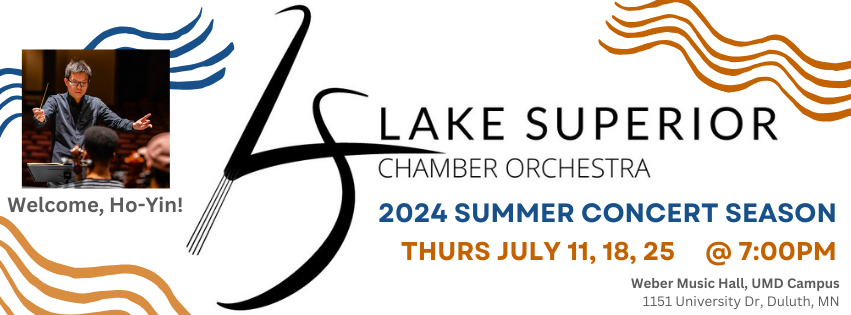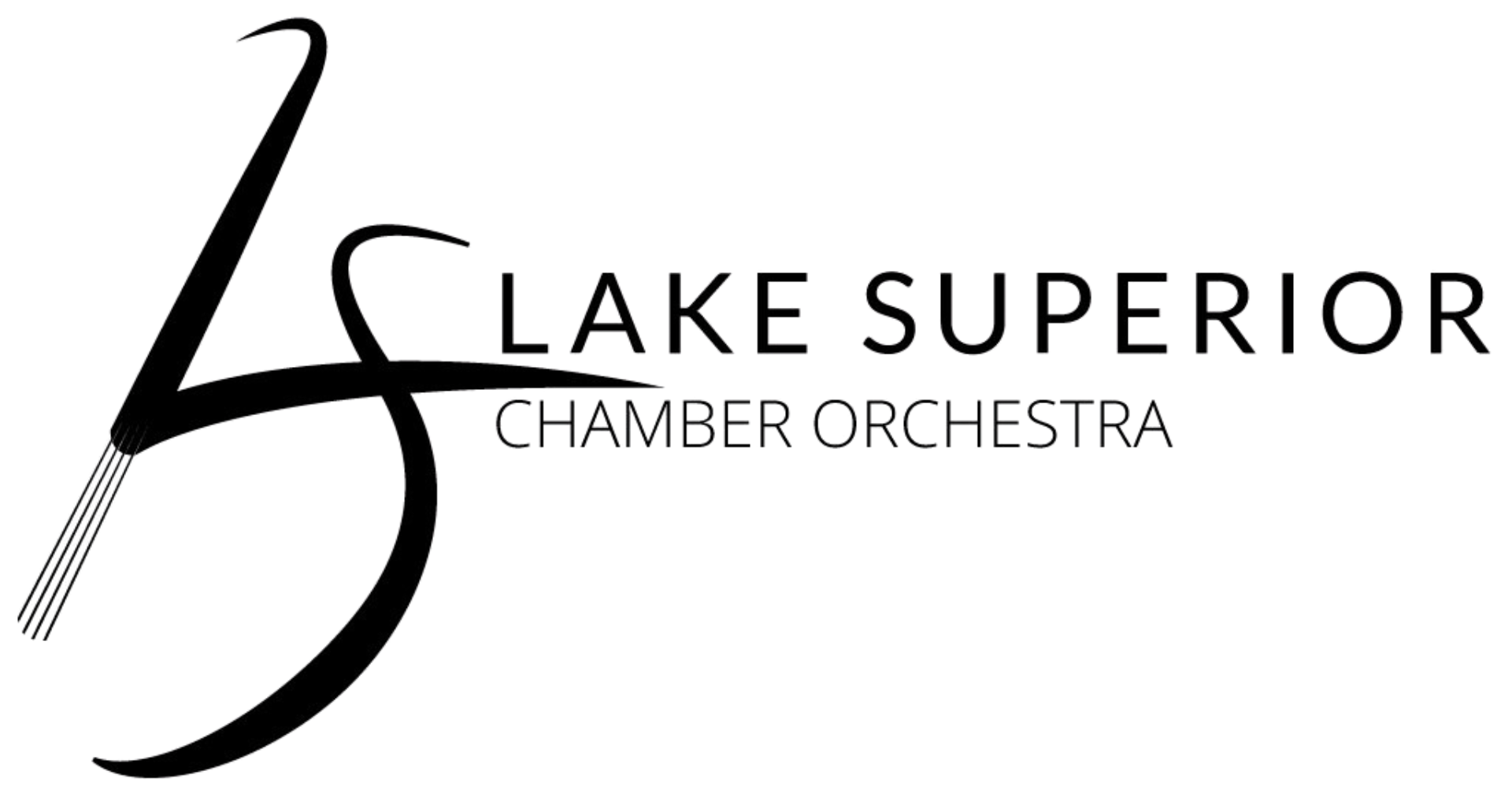2024 Season
- By LSCO Duluth Info
- Posted in
- On February 11, 2024

Join Us for the LSCO's 2024 Season!
Thurs: July 11, 18, 25 @7:00PM
Weber Music Hall, University of MN Duluth Campus
Concert evenings begin at 6:00PM, Weber Hall lobby doors open.
Concert Hall & Seating Opens at 6:30PM.
Message from the Music Director
I am delighted to have join us this summer as the Lake Superior Chamber Orchestra opens its 38th season.
This season we honor the contribution of Warren Friesen, our Founding Music Director since 1987, and celebrate the continuation of the excellent traditions of this orchestra. As a result, the three programs of this summer feature pieces by Mozart, Penderecki, Shaw, Britten, Webern, and Tippett that utilize contemporary compositional technique in paying tribute to musical forms of the past
As the new Music Director of LSCO, I am proud to be part of this vibrant cultural organization that seeks to expand the artistic boundaries and enrich the living quality of our community. As we enter this exciting period of growth, I am grateful for our generous donors and patrons who believe the value in artistic investment. I am deeply honored to continue the great legacy of LSCO. Music is most powerful when it is shared. So please sit back and enjoy the music. Thank you for your continuous support.
~ Ho-Yin Kwok
Season Welcome
The Young Artist Piano
Camp Collab
The Quartet Project
&
Celebrate
Our
Founder and Future
Thurs,
July 11,
7:00 pm
We welcome Ho-Yin Kwok as our new conductor and artistic director.

Thurs,
July 18,
7:00 pm
The Young Artist Piano Camp is returning to Duluth and will be collaborating with the LSCO for our July 18th concert. The winner of the Piano Camp concerto competition will perform with the LSCO.

Thurs,
July 25,
7:00 pm
We welcome LSCO founder Warren Friesen to our July 25th concert. Mr. Friesen will be working with The Quartet Project students and will conduct the combined LSCO/QP piece during the concert. We will also celebrate Mr. Friesen’s considerable achievements with the LSCO at this concert.

Program Notes
(Subject to Change)
July 11~
Season Welcome
Mozart ….. Adagio and Fugue in C minor, K. 546 ….. 7′
Based on a piece Mozart wrote earlier for two pianos, the Adagio and Fugue starts with an ominous and mysterious Adagio section and launches into the energetic Fugue with an almost Beethovenian determination and pathos.
Penderecki ….. Polish Requiem, Ciaconna (2005) …..7′
Pendercki wrote the Polish Requiem in 1984 to commemorate the heroes and victims of Polish history, especially those who were killed in the anti-government riots in 1970. In the following years, he expanded the piece with more movements with the Ciaconna being the last addition in 2005. The Ciaconna was written in memory of Pope John Paul II.
Shaw ….. Entr’acte (2011) ….. 12′
Caroline Shaw wrote Entr’acte in 2011 after hearing the Brentano Quartet play Haydn’s Op. 77 No. 2. Inspired by their playing of the minuet and trio, this piece is structured like a minuet and trio, riffing on that classical form but taking it a little further. Entr’acte evokes the feeling of Alice’s looking glass with its absurd, subtle, technicolor transitions.
Britten ….. Variations on a Theme of Frank Bridge, op. 10 ….. 27′
Benjamin Britten wrote the variations as an homage to his composition teacher, Frank Bridge. It starts with a robust introduction, followed by a theme extracted from Bridge’s Three Idylls for string quartet. It is followed by ten variations, each reflects one personal quality of Bridge: the Adagio represented Bridge’s integrity; the March was his energy; the Romance his charm; the Aria Italiana his humor; the Bourrée his tradition; the Wiener Walzer his enthusiasm; the Moto perpetuo his vitality; the Funeral March his sympathy; the Chant was his reverence; the Fugue was his skill (it contains a number of references to other works by Bridge); and their mutual affection appears in the Finale.
July 18~
The Young Artist Piano Camp Collab
Bach/Webern ….. Ricercar a 6, BWV 1079/5 ….. 9′
Bach’s six-part fugue from The Musical Offering is a compositional miracle. Its theme is a challenge presented by Frederick II, using all 12 notes from the chromatic scale. Inspired by the composition, Anton Webern transposed the piece almost 200 years later for an orchestra using the technique of Klangfarben-melodie (using tone color as a melodic element) which adds an unlimited amount of coloristic possibility to the piece.
Chopin ….. Piano Concerto No. 2, op. 21 ….. 15′
II. Larghetto
III. Allegro vivace
Chopin’s Piano Concerto No. 2 is actually his first completed piano concerto. Written in 1829, it preceded his “No. 1” by one year but was published later. The second movement is known for its “indescribable beauty” and extreme lyricism, filled with Chopinian ornaments and melismatic figures. The third movement resembles a polish Mazurka, which is filled with rhythmic vitality and special string techniques.
Mendelssohn ….. Symphony No. 4, op. 90 ….. 30′
From 1829 to 1831, Mendelssohn embarked on a grand European tour that became inspirational to many of his most known compositions. The “Italian Symphony” was Mendelssohn’s reaction to his time in Italy, where he started the sketch of the work. The first movement is filled with Mendelssohn’s joyful and impulsive energy. The second movement recreates the impression of a religious procession the composer witnessed in Naples. The third movement is a graceful minuet and trio featuring the horns in the middle section. The work ends with a fiery Finale that incorporates dance figurations from the Italian saltarello. The fast and furious dance concludes the A major symphony in minor key, which makes it one of the very few symphonies that contain a major-to-minor trajectory.
July 25~
The Quartet
Project
&
Celebrate Our
Founder and
Future
Tippett….. Divertimento on Sellinger’s Round (1954) ….. 16′
For the occasion of the coronation of Queen Elizabeth II, six British composers wrote a collection of six variations on an Elizabethan theme called the “Sellinger’s Round.” Michael Tippett was particularly fond of his contribution in this project that he further developed his variation in a Divertimento of five movements. In each movement, Tippett features a dialogue between the Sellinger’s Round theme and one other composition written by a British composer of the past, including Gibbons, Purcell, Arne, Field and Sullivan.
Wang ….. Violin Concerto “Swept Away” (2023) ….. 24′
James Zabawa-Martinez, violin
Swept Away is dedicated to the memory of the composer’s father, Phillip Wang, who died of cancer. At its essence, this concerto tells the story of what it feels like to lose someone you love, and the complex ways that we carry on in the aftermath of tragedy. The first movement, I Saw a Stranger, describes what it felt like to see the patient in his final hour. The timpani represents a slowing heartbeat. The second movement, Hollow, depicts the numbness that the composer felt for months after his passing. The substantial cadenza depicts a moment where the emotions almost escape. The third and final movement, Life After Death, opens up sonically and musically, representing an optimism of a living memory and moving on into the world again. The story moves from darkness to light, sadness to hope, solitude to friendship, and pain to peace. Swept Away is dedicated to anyone who has had their lives “swept away” by cancer.
Guest performer, a native of Austin, Texas, violinist James Zabawa-Martinez has performed concerts and recitals throughout the US and Europe. Before joining Kansas City Symphony in 2023, James was a violin fellow at the New World Symphony for two years, where he performed frequently as concertmaster under the baton of Michael Tilson Thomas. James has performed with orchestras such as The Cleveland Orchestra, Minnesota Orchestra, Utah Symphony, Indianapolis Symphony, and Buffalo Philharmonic.

Side-by-Side pieces with The Quartet Project, conducted by Warren Friesen … 15′:
Kenji Bunch ….. Supermaximum (2014)
Jean Sibelius ….. Andante Festivo (1922)


